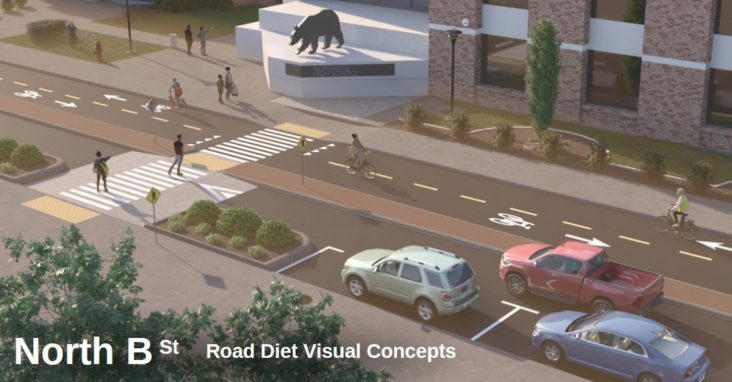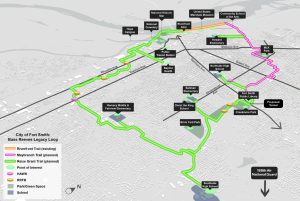Bass Reeves Legacy Loop part of Fort Smith mobility strategy
by May 13, 2024 5:02 pm 3,495 views

Rendering of proposed changes to B Street in Fort Smith
Fort Smith’s mobility master plan is looking to create nine miles of new greenways, rehabilitate alleyways and improve B Street mobility. The city also is pursuing a $25 million grant to fund a proposed Bass Reeves Legacy Loop trail.
Michael Mings, mobility coordinator for the City of Fort Smith, reported on the city’s mobility plans to the Future Fort Smith Committee at its meeting Monday (May 13).
“We are pursuing trails, greenways and protected bikeways for a number of reasons,” Mings said. “We want to remove transportation barriers within our community, helping people to get where they are trying to go.”
Mings said mobility improvements can also be a public health initiative, helping people move their bodies to be healthier. Trails and greenways can also reduce household transportation expenses. Helping a family move from a two-car family to a one-car family can save the family $600 a month in expenses, he said.
“And most importantly, we have the opportunity to implement safety improvements and create the kind of city where people will feel comfortable and enjoy walking and biking around town without having to worry for their safety or get hit by a car,” Mings said.
The city is making progress in these areas, Mings said, thanks in part to state and federal governments supporting initiatives that had bikes and greenways.
“There is more money out there than ever has been before for implementing these kinds of things,” Mings said.
LEGACY LOOP
The city has applied for a $25 million federal RAISE grant for the Bass Reeves Legacy Loop, a 14-mile greenway loop with new and existing trails. The loop would include nine miles of new trails giving a safe route to schools, parks, jobs, medical care and essential services, Mings said, adding that 20% of Fort Smith residents will live within ½ mile of the loop. The loop would connect eight schools in order to allow students to more safely walk or ride bikes to schools, Mings said.

“We want to see more bikes on bike racks at public schools and less cars in the pickup and dropoff lines,” he said.
It will be within 0.5 miles of 20 public transit sites, which will help residents navigate and transverse the city more cohesively, he said. Because new greenways will tie in with the city’s Riverfront Trail and with the Maybranch Greenway, which is to be started this year, it will connect residents more easily with city parks, something the city has learned through meetings and surveys is the top thing residents would like to see trails within the city do, Mings said. With a tunnel that would cross under Rogers Avenue at the Fort Smith Public Library and connect to Creekmore Park, the loop will also give a safe pedestrian path connecting the north and south sides of the city.
The loop aims to improve community mobility, public health, and social cohesion while commemorating the life and legacy of Bass Reeves.
“It is fitting that this project celebrates the life and legacy of Bass Reeves, whose remarkable story epitomizes resilience, justice, and progress. Bass Reeves’ journey from enslavement to becoming one of the first Black law enforcement officers in the American West is a powerful inspiration for overcoming adversity. By honoring his legacy through the Bass Reeves Legacy Loop, we not only pay tribute to his contributions to Fort Smith, but we also reaffirm our commitment to creating a more equitable community for all residents, regardless of background or circumstance,” noted the grant application.
He said the city should learn in June if it receives the grant. If it does, building the loop will take five to six years, at least, Mings said.
ALLEYWAY WORK
The city has also applied for an Environmental Protection Agency (EPA) grant for alleyway rehabilitation.
“In order to reduce climate pollution, the EPA is targeting the transportation sector as the main way to reduce carbon emission,” Mings said. “The city has an extensive alleyway network, and they are not being used nearly as they should be.”
The grant application focuses on nearly three miles of alleywork networks on the north side of the city that would become paved greenways connecting the northside of town to grocery stores, Northside High School, places around Grand Avenue and more, he said. Three alleyways – North E Street to North O Street, North 16th Street to Belle Avenue, and North C Street to Tilles Avenue – are included in the plan with a total estimated cost of $5.1 million. The alleyways will be a shared use facility but more like a trail or greenway. They would allow local access to backyards and backs of homes, Ming said.
“This represents a huge possibility,” said Tim Varner with the Future Fort Smith Committee. “It gives back to the neighborhood. It has the cool look and lure of trails, but it is a functional balance between connectivity and recreation.”
B STREET PLANS
Mings said the city is also considering B Street mobility improvements, which he said is the city’s No. 1 of 6 catalytic mobility improvement ideas.
“The street is way too wide and has relatively low traffic with parking on both sides. We need to reconfigure it for all modes of transportation,” Mings said.
Mings said there is “a lot going on on B Street,” and improving the mobility of the street could improve it so there is a better means of getting from Northside High School all the way to the Riverfront Trail. The project would connect with several of the Future Fort Smith policies, he said. It would provide convenient, safe connections between neighborhoods and destinations such as downtown, employment centers, schools, parks, shopping areas and neighborhood services.
It would improve and create bike and greenways that interconnect neighborhoods and provide access to both neighborhood and city-wide destinations. And it would help work towards a “complete streets” approach that ensures new projects are designed and planned to meet the needs of every community member, regardless of age, ability or how they travel.
“I think the plans fit into each other as a network, and they really work to get people to downtown,” Ming said. “These are the kind of things the city should be prioritizing.”
